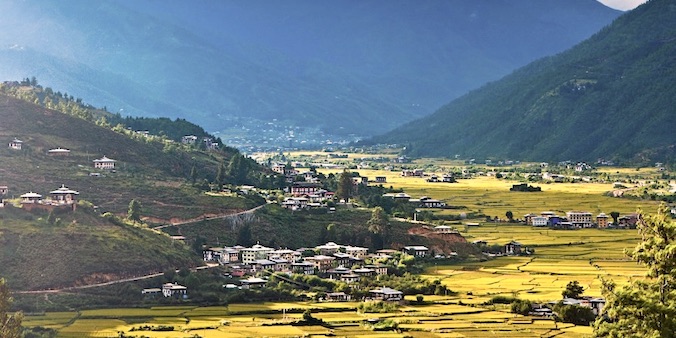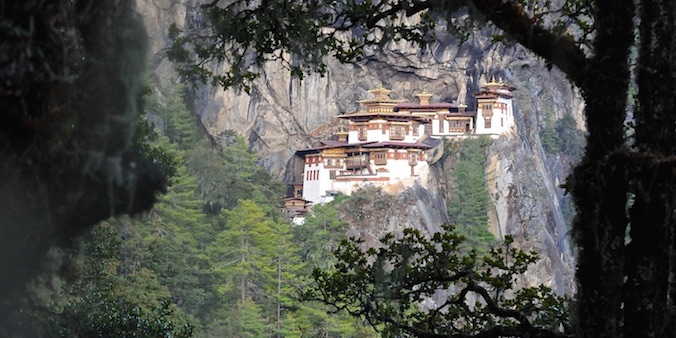WEST BHUTAN with DRUK PATH TREK
Tour - 16 days/ 5 days trekking
WEST BHUTAN with DRUK PATH TREK
Tour - 16 days/ 5 days trekking
About BHutan
Bhutan is not your average destination. And that’s the understatement of the century. For starters, it’s the only remaining Buddhist Himalayan kingdom, the only one that managed to escape assimilation by either China or India. Being only the size of Switzerland and having just over 700,000 inhabitants, that’s quite a feat in itself.
Bhutan is mainly known for its very original culture and nature. This is largely due to the centuries of isolation, but also to the deliberate policies of the present government and of the kings in the past. Until the seventies, hardly any foreigner ever had set foot in the secluded kingdom.
Read more…Read less…
HAPPINESS OVER WEALTH
However, in 1972, at the occasion of the crowning of king Jigmed Singye Wangchuk, many foreign guests were invited to Bhutan. Having studied in the U.K., the future king obviously saw it coming that especially the western guests would observe a discrepancy between their own standard of living and that of the Bhutanese. In his opinion, the Bhutanese were not poor, but merely lacking in some amenities and products available in the West, most of them non-essential. Otherwise, the Bhutanese were actually quite well off, he felt. Almost all of them had a beautiful, spacious farmhouse, more than enough forests, arable land and animals to be fully self-sufficient in terms of heating, construction and nourishment. And, most importantly, a culturally defined sense of identity, belonging and security that made most of them very content and happy beings. The king had observed otherwise in the west.
In order to explain this to his foreign guests, he coined the term ‘gross national happiness,’ a clever term obviously meant to be juxtaposed with what seemed to be the aim of most governments, a high gross national product. The rest is history, one could say. These days, all over the world, conferences and workshops are being held on happiness and, more in general, on how to develop and emphasize those qualities of life that can not be measured in dollars or euros.
Bhutan does not claim that its inhabitants are the happiest in the world, but it does place overall happiness above wealth. These days, GNH, as it is generally referred to, is the formal pillar and yardstick of all government policies. After the king abdicated his powers in favor of a democratically elected government, Bhutan has seen four governments. All of them have continued to place GNH above anything else.
As a result, Bhutan has protected its culture – largely defined by Buddhist beliefs – but also its forests, mountains, rivers and wildlife much better than any other country in Asia. Key to all this is a reliable, non-corrupt government, which itself is one of the four pillars of GNH and, frankly, quite the exception in the region.
On your trip through Bhutan you will see numerous temples, monasteries and dzongs (monastery castles), better preserved and more lavishly decorated than anywhere else in the ‘Tibetan’ realm. Not less impressive, if alone because of their rustic beauty, are the many traditional houses, as well as meeting the friendly, warm-hearted people who embrace their culture as a precious heritage.
Read more…Read less…
Bhutan is also extremely mountainous and rich in nature, especially forest – in fact, it is the most wooded country in Asia. The southern border consists of hills and low mountains with dense jungle where elephants and tigers roam, and people live in bamboo houses surrounded by rice fields. But in the central highlands, at an altitude of 1500 – 2500m, people live in small enclaves of farms reminiscent of Swiss chalets, surrounded by endless coniferous forests. Travelling through this area (and when you fly over it) you will occasionally catch a glimpse of the northern and highest parts, where the semi-nomadic yak shepherds live and which are bordered by glacier-covered Himalayan peaks. The only way to see all this up-close is to set out on a seven-day (or more) camping trek.
Region
Bhutan
Best Time
April-May &
Oct-Dec
No. Of Days
16 days, 5 days trek
Trip Character
Jeep tour with trek
Sleeping Altitude
1400 - 4110 m
Trek Character
Camping trek
Level: 2
Price
INR XXX/ $ XXX
ABOUT THIS TOUR
On this tour you’ll do a short five-day trek, that leads high into the mountains. This trek, called the Druk Path Trek, leads from Paro to Thimphu, crossing the chain of mountains that separates the two valleys. Although the route is sparsely inhabited, there are wonderful lakes teeming with fish and the area is famous for its spectacular rhododendron forests, which bloom in May. In the clear weather of late autumn and winter, the Druk Path trek offers great views of the Himalayas.
Apart from the trek, you’ll explore the highlights of western Bhutan by car , such as Paro with its phenomenal Tigersnest Monastery, the capital Thimpu, and Punakha, where Bhutan’s most impressive dzong is situated.
Best months: Late February to June and September to DecemberYOUR custom-made TRIP
The tour described here, as well as the other ones on our website, are mainly meant as suggestions. We would be happy to offer you a travel proposal that fully meets your personal demands and expectations. That means that you choose where you want to go, what level of accommodation and type of transport you want and what activities you prefer.
Please let yourself be inspired by this and other trips on our website and then drop us a line (or call us) to explain your travel wishes. We will be happy to help you put together the perfect trip. You can reach us over e-mail, Messenger, Whatsapp or mobile phone.
EXTENSIONS & VARIATIONS
Apart from the tour as described here, you could consider the following add-ons and changes:
- Spend another day in Thimphu, for instance at the end of the tour. Because, although Thimphu is by far Bhutan’s most ‘mundane’ place, it has a lot to offer in terms of culture, restaurants and cafes, shopping, and a very pleasant atmosphere.
- Spend a day rafting on the Paro River. There are different grades available, so there is the easy-but-fun-to-do level as well. Professional oarsmen will be with you in any case. You will be picked up from your hotel and dropped off there again at the end of the day, a pic-nic lunch is included.
ITINERARY
-
.fa-info {color: #1146a9;}.fa-info:hover {color: #387dff;}Day 1: Delhi ✈︎ Paro & drive to Thimphu (1.5 h)
The flight to Paro (Bhutan) takes less than 2,5 h and, in clear weather, affords wonderful views of the Himalayas, including Mt. Everest (8848m) and Kangchenjunga (8568m). At the airport our guide and driver await you outside the airport, and will take you to Thimphu, the capital. On this short drive, you'll get a first glimpse of Bhutan's forests and rustic, half-timbered houses. Altitude 2350m. a:hover {color: #1146a9; background-color: transparent; text-decoration: underline; } -
Day 2: In Thimphu
You have the whole day to explore Thimphu. Besides the many options listed in the highlights below, you can visit the archery range and the animal park with the takin, the national animal of Bhutan. Or you can walk to a nearby monastery in the woods with beautiful views. Altitude 2350m. -
Day 3: Thimphu - Punakha (2.5 h)
Driving eastwards over the only road that connects the capital with middle and East of Bhutan you'll cross the 3120m high Dochu La (‘La’ = ‘pass’). Here, you get beautiful views of the Himalayas, before descending to the relatively warm Punakha valley. Altitude 1400m. -
Day 4: In Punakha
Today, you'll explore several sights of Punakha, most importantly Punakha's magnificent dzong. A dzong is a uniquely Bhutanese and Tibetan phenomon. It is a monastery, district administration office and (in the past) military fort at once. Altitude 1400m. -
Day 5: Punakha - Phobjikha
Traveling further to the east, you reach the beautiful, high valley of Phobjikha. Altitude 1400 → 2900m. -
Day 6: In Phobjikha
Phobjikha is a protected conservation area where black-necked cranes live. On a walk through the valley you hopefully will see the cranes. And you visit Gangte Goemba (goemba=monastery), belonging to the Nyingmapa, the oldest Buddhist sect in Bhutan and Tibet. Altitude 2900m. -
Day 7: Phobjikha - Haa (8 h)
A rather long ride takes you back to Thimphu and further west. Halfway Thimphu and Paro, at Chuzom, you take one of the most scenic routes in the country to the very authentic Haa valley. Altitude 2900 → 2670m. -
Day 8: In Haa
Today you’ll visit Lhakhang Kharpo, the largest temple in the area, and take several short walks in the countryside, visiting rustic villages and climb up to small, hidden monasteries. Altitude 2670m. -
Day 9: Haa - Paro
First we drive up to the Chele La (3988m) with fantastic views of the Himalayas. Then we hike down to a nunnery monastery, set dramatically at the foot of a steep cliff. The car brings you to Paro. The afternoon can be spent on visiting the pleasant centre of Paro, the dzong and adjacent National Museum or maybe the medieval Kyichu Lhakhang (lhakhang=temple). Altitude 2670 → 2250m. -
Day 10: in Paro, walk to Tigersnest
Today you do the well-known hike to legendary Taktsang Goemba, better known as Tiger’s Nest. It is 2.5 h walking up and 1.5 h down, but the magical little temple is worth it. Altitude 2250 → 3120 → 2250m. -
Day 11: Paro - Jele Dzong (3 h)
Today’s hike through orchards and forests is short but demanding, as you climb around 1000m to your nice camp below Jele Dzong (monastery fortress). In clear weather Paro valley can be seen with snow-capped mountains behind it. Altitude 2450 → 3435m. -
Day 12: Jele Dzong – Rabana (3-4 h)
After a possible visit to Jele Dzong and its impressive lhakhang (temple) you first climb through a rhododendron forest to a first saddle and continue to a second one at 3750m with – weather permitting - fine views of Paro, Jomolhari (7315m) and other snowy peaks. Camp is near a yak herders’ site. Altitude: 3435 → 3890m. -
Day 13: Rabana – Langye Ja La - Jimilangtsho (4 h)
Following the ridge the trail climbs to Langye Ja La (4070m; la = pass) with on a clear day sensational views of mountains and valleys. Camp is close to the sacred Jimilangtsho lakes, famous for their giant trout. Altitude 3890 → 4070 → 3880m. -
Day 14: Jimilangtsho – Labana (9 h)
This is the most strenuous day of the trekking, as it involves several minor climbs to small passes and many hours of walking. But - weather permitting - you will be greatly rewarded with majestic views of Mt. Gangkar Puensum (7570m) and a host of other peaks. Today’s route takes you through dwarf rhododendron forests, past some yak herders’ camps and the lakes of Janye and Simkota Tsho. Altitude 3880 → 4150 → 4110m. -
Day 15: Labana - Thimphu (3 h)
After a short climb to Labana La (4235m) the trail passes through juniper and blue pine forests and is more or less downhill till the end near Thimphu including some steeper sections. A car takes you to a comfortable hotel in Thimphu. Afternoon leisure time. Altitude 4110 → 4235 → 2560 (end of trek) → 2350m. -
Day 16: Thimphu – Paro & Paro ✈︎ Delhi
Transfer from Thimphu to Paro (1,5 h). A morning flight brings you from Paro to Delhi, hopefully again with wonderful views of the Himalayas. If you have asked us to arrange accommodation and transfers in Delhi you will be picked up from the airport by our driver.
HIGHLIGHTS OF THIS TOUR
Flight to Paro

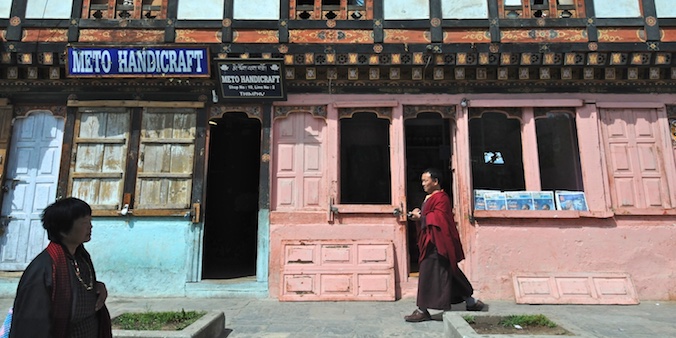
Thimphu
Sights of Thimphu


Punakha Dzong
Punakha - Other Sights
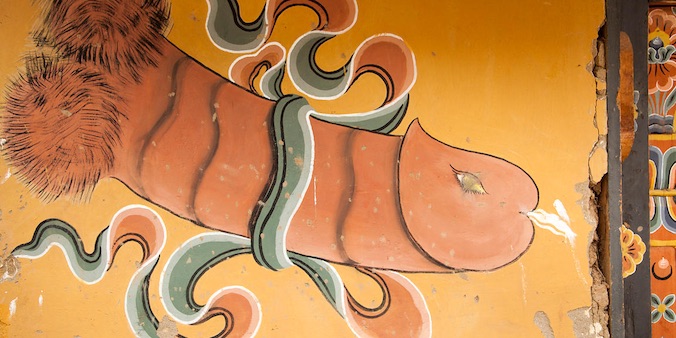
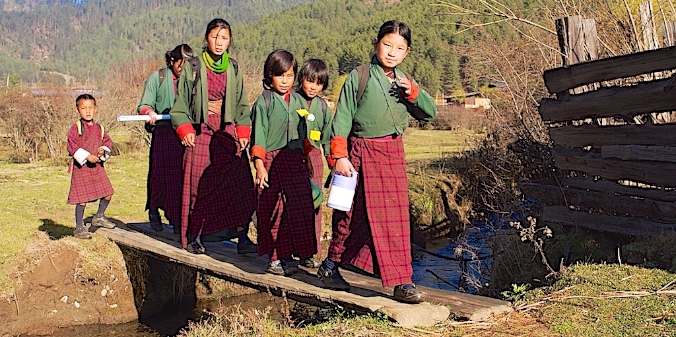
Phobjikha
Walks at Phobjikha
Phobjikha is not just a protected area, it is walkers paradise as well. Th three main valleys that converge near Gangte, where you will stay, offer gently sloping mountain sides with meadows and forests teeming with birds, interspersed with small hamlets of traditional farms. On the day you’re leaving Phobjikha, you’ll be offered the option of trekking rather than driving out. In case you are traveling west, you climb and then cross a pass to the northeast. You’ll get splendid views of Trongsa Valley, and, wheather permitting, of the Great Himalayan Range. After descending down to the road, the car will pick you for the onward journey. If you’re traveling west, you can take a similar walk, crossing a pass and descending through a magnificent rhododendron forest to the road to Punakha.
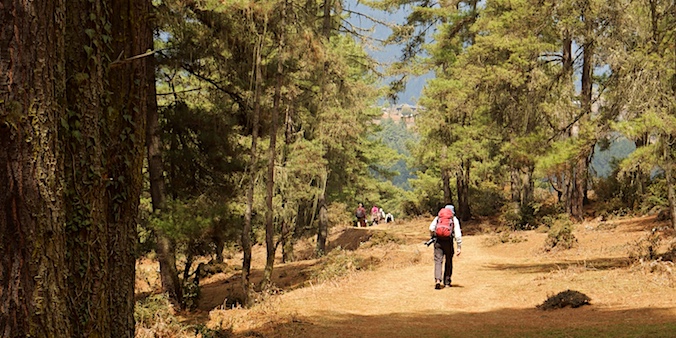
Road Chuzom - HAA
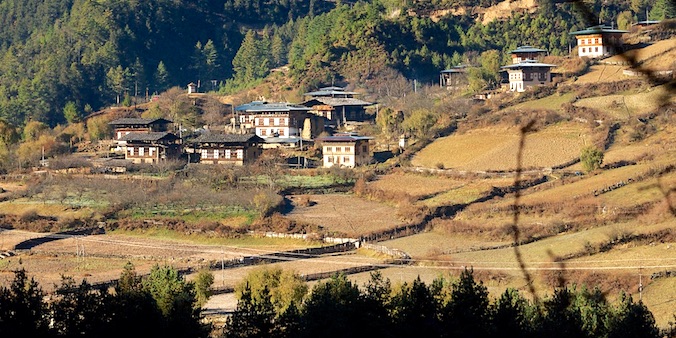

Chele La
From the Paro Valley you climb to Bhutan’s highest motarable pass, the Chele La (3988m). The narrow road creeps up through magnificent forests of enormous cedars, spruces and larches, a well as tree-high rhododendrons (which normally bloom in April-May). Once up, weather permitting, you will be treated to beautiful views of the Himalayas, especially Mt. Jhomolhari (7329 m) right on the Tibetan border. The best view you get from the road, 100 m north of the pass. Descending, you reach the green-forested Haa Valley. It can be chilly here in the evening, but the wood stove in the resort is always on.
Paro
